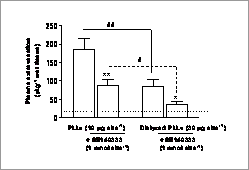The plasma protein extravasation induced by polistes lanio lanio wasp venom in the mice skin: involvement of sensory-c fibers Stings by Polistes sp wasps, found in Brazil, are of clinical interest as they can cause life-threatening allergic reactions, pain and inflammation (Castro et al., 1994). However, little is known about the biological activity and composition of the venom. This study was undertaken to investigate the effects evoked by Polisteslanio lanio venom (PLLv) in the cutaneous microvasculature and to identify active inflammatory peptides. Both male and female C57BL/6 mice (25- 30 g) and Wistar rats ( 200 g) anesthetised with urethane ( 25% w/v, 100 μl 10 g-1) were used. 125I-albumin (0.03 MBq/0.1 ml) was injected into the tail vein. Intradermal injection (i.d.; 0.05-0.10 ml) of test agents was made into the shaved dorsal skin. Following 30 min period accumulation, animals were killed and skin oedema was assessed via extravascular accumulation of 125I-albumin (Costa et al., 2003). T he venom was collected by compressing the venom sac and then was lyophilized and sometimes dialyzed (MW cutoff 2000). The nano-electrospray ionization analysis of venom-containing peptides was carried out via Q-TOF mass spectrometer (Micromass, U.K.) coupled to a CapLC chromatographic system. The MS/MS spectra was processed using MaxEnt3 and sequenced via PepSeq software. P LLv (0.3-30 μg site-1) caused a potent and dose-dependent oedema formation into the dorsal skin of mice (not shown; n=3-8). The venom EC50 (7 μg)-induced oedema was unaffected by the bradykinin B2 receptor antagonist HOE 140 (0.8 nmol kg-1; i.v.) but partly reduced by the B1 receptor antagonist Des-Arg9-[Leu8]-BK (3 μmol kg-1, i.v.; 269 ± 28 and 94.5 ± 35* μl site-1, control and treated, n=3-4). Dialysis of PLLv reduced the oedema by 50% (Fig. 1). The substance P NK1 receptor antagonist SR140333, but not NK2 (SR48968), markedly reduced PLLv-evoked oedema (Fig. 1). Capsaicin treatment to deplete neuropeptides inhibited PLLv-induced response in rats (not shown; n=4). Analysis by mass spectrometry (Q-TOF/CapLC) shows that PLLv contains peptides (MW 1173 – 3581) that share C-terminal sequences with mammalian tachykinins. Fig. 1 Effect of raw and dialyzed PLLv in the absence and presence of SR140333 (1 nmol site-1; n=7-8) in the mice skin. *P<0.05 and **P<0.01 vs PLLv without SR140333. #P<0.05 and ##P<0.01 dialyzed PLLv vs raw venom.
These findings provide new evidence that PLLv-induced inflammatory effect in the skin of rodents is largely mediated by the action of tachykinin-like peptides, in a manner similar to the endogenous neuropeptide Substance P. The venom-induced oedema may also involve activation of BK B1 receptor in the cutaneous microvasculature.
Castro, F.F.M. et al. (1994). J. Investig. Allergol. Clin. Immunol., 4, 37-41. We thank CNPq, Capes and FAPES P for financial support. |


